- The Threat of Colorado Potato Beetle
- Life Cycle and Feeding Habits
- Damage Caused by Colorado Potato Beetle
- Management of Colorado Potato Beetle
- The Need for Non-chemical Methods
- Advantages of Non-chemical Methods:
- Non-chemical Methods for Colorado Potato Beetle Control:
- Integrated Pest Management Techniques
- 1. Crop Rotation
- 2. Biological Control
- 3. Trap Crops
- 4. Mechanical Control
- 5. Cultural Practices
- Conclusion
- Crop Rotation
- How does it work?
- Steps to implement crop rotation:
- Benefits of crop rotation:
- Conclusion
- Biological Control Agents
- Ladybugs:
- Ground beetles:
- Parasitic wasps:
- Nematodes:
- Fungi:
- Physical Barriers
- Types of Physical Barriers
- Benefits of Physical Barriers
- Organic Insecticides
- Neem Oil
- How does neem oil work?
- How to use neem oil?
- Benefits of using neem oil:
- Diatomaceous Earth
- Traditional Methods
- Handpicking
- Row Covers
- Crop Rotation
- Natural Predators
- Trap Crops
- “Question-Answer”
- What is the Colorado potato beetle?
- Why is the Colorado potato beetle considered a pest?
- What are some natural methods to eliminate Colorado potato beetles?
- Why should we use non-chemical methods to control Colorado potato beetles?
- Is crop rotation an effective method to control Colorado potato beetles?
- Are there any downsides to using non-chemical methods to control Colorado potato beetles?
- “Video” Dealing With Potato Pests | Colorado Potato Beetle | Potato Tuber Moth | Leafminer Fly
The Colorado potato beetle (Leptinotarsa decemlineata), also known as the potato bug or potato beetle, is a destructive pest that can cause significant damage to potato crops. Traditionally, farmers have relied on chemical pesticides to control infestations of this voracious pest. However, there is a growing interest in finding non-chemical methods to eliminate the Colorado potato beetle naturally.
One approach to managing the Colorado potato beetle without chemicals is through cultural practices. Crop rotation, for example, can help disrupt the beetle’s life cycle by preventing them from laying eggs and overwintering in the same location. Planting resistant potato varieties can also be effective in reducing beetle populations, as these varieties have natural defenses against the pest.
In addition to cultural practices, biological controls can be utilized to naturally control the Colorado potato beetle. One method is the introduction of natural predators, such as ladybugs or lacewings, which feed on the beetle larvae and adults. Another option is using bacteria-based insecticides, such as Bacillus thuringiensis, which specifically target certain pests without harming beneficial insects.
Furthermore, mechanical methods can be employed to physically remove Colorado potato beetles from plants. Handpicking is a labor-intensive but effective method, especially for small-scale gardeners. Another mechanical approach is to use floating row covers or screens to physically prevent the beetles from accessing the potato plants.
By implementing these non-chemical methods, farmers can reduce their reliance on chemical pesticides and create a more balanced and sustainable approach to managing the Colorado potato beetle. Not only does this benefit the environment by minimizing chemical pollution, but it also promotes the health and quality of the potato crops.
The Threat of Colorado Potato Beetle
The Colorado potato beetle, also known as Leptinotarsa decemlineata, is a significant pest of potato crops worldwide. Its adaptability, reproductive capacity, and ability to develop resistance to chemicals make it a constant threat to potato farmers.
Life Cycle and Feeding Habits
The beetle’s life cycle consists of four stages: egg, larva, pupa, and adult. The female beetle lays orange-colored eggs on the undersides of potato leaves, typically in clusters. After about a week, the eggs hatch into larvae, which are reddish-orange with black heads. The larvae feed voraciously on the leaves, and as they grow, they molt and change color from orange to yellow to pink to dark brown. After a few weeks, the larvae burrow into the soil to pupate and emerge as adults within a couple of weeks.
The adults are approximately 1/4 inch long, with a yellow- or orange-colored body and ten black stripes on their wing covers. They continue feeding on the leaves, defoliating the plant, and can quickly destroy an entire potato crop if left unchecked.
Damage Caused by Colorado Potato Beetle
The feeding habits of Colorado potato beetles can cause severe damage to potato plants. They feed on the leaves, which are crucial for the plant’s photosynthesis and growth. The loss of foliage reduces the plant’s ability to produce nutrients and affect tuber formation and overall crop yield.
In addition to reducing the yield, the beetle’s feeding damage may also make plants more susceptible to other diseases and pests. Furthermore, the presence of Colorado potato beetles in potato fields can lead to a decrease in crop quality, as the damage caused by the beetles may leave the tubers more vulnerable to rot and other storage-related problems.
Management of Colorado Potato Beetle
Traditionally, chemical insecticides have been the go-to method for controlling Colorado potato beetles. However, the adversarial relationship between the beetle and chemical control measures has led to the development of resistance, making it necessary to explore alternative management strategies.
Non-chemical methods, such as crop rotation, mechanical removal, and biological control, have gained attention as sustainable and environmentally friendly alternatives. These methods aim to disrupt the beetle’s life cycle, reduce its population, and minimize the need for chemical interventions.
| Method | Description |
|---|---|
| Crop rotation | Planting potatoes in different areas each year to reduce the persistence of the beetle in the soil. |
| Mechanical removal | Hand-picking adult beetles and larvae from plants and destroying them. |
| Biological control | Introducing natural enemies of the beetle, such as predators and parasitoids, to keep its population in check. |
By combining these non-chemical methods with other sustainable practices, potato farmers can mitigate the threat of Colorado potato beetles and maintain healthier and more productive potato crops.
The Need for Non-chemical Methods
Pesticides and chemical insecticides have long been used to control pests in agriculture, including the notorious Colorado potato beetle. However, the overuse of these chemicals has resulted in a range of negative consequences, including the development of resistance in target pests, harm to beneficial insects, and the contamination of soil and water.
As a result, there is a growing need for non-chemical methods to control pests like the Colorado potato beetle. These methods are environmentally friendly, sustainable, and safer for human health. Additionally, they can help to maintain the natural balance of pest and predator populations, reducing the reliance on chemical interventions.
Advantages of Non-chemical Methods:
- Environmental Benefits: Non-chemical methods reduce the pollution and contamination of soil, water, and air that can occur as a result of chemical pesticide use.
- Health Benefits: Non-chemical methods are safer for farmers, agricultural workers, and consumers who may come in contact with pesticide residues on crops.
- Biodiversity Conservation: By avoiding the use of chemical insecticides, non-chemical methods can help to protect beneficial insects, birds, and other organisms that play a crucial role in maintaining ecosystem balance.
- Sustainable Agriculture: Non-chemical methods promote sustainable agricultural practices by reducing the dependence on synthetic chemicals and fostering innovation in pest management strategies.
Non-chemical Methods for Colorado Potato Beetle Control:
There are a range of non-chemical methods that can be used to control the Colorado potato beetle naturally:
- Row Covers: By placing row covers over potato plants, adult beetles are prevented from laying eggs on the foliage, effectively reducing the population.
- Handpicking: Regularly inspecting plants and manually removing adult beetles, larvae, and eggs can help to reduce infestation levels.
- Trap Cropping: Planting trap crops, such as eggplant or mustard, can attract Colorado potato beetles away from potato plants, making it easier to control their population.
- Biological Control: Introducing natural enemies of the Colorado potato beetle, such as parasitic wasps or ladybugs, can provide effective long-term control without the use of chemicals.
By adopting these non-chemical methods, farmers can take a proactive and sustainable approach to controlling the Colorado potato beetle, minimizing the negative impacts associated with chemical pesticide use and promoting a healthier and more environmentally friendly agricultural system.
Integrated Pest Management Techniques

Integrated Pest Management (IPM) is a holistic approach to pest control that focuses on preventing and managing pest infestations by using a combination of techniques. These techniques are aimed at minimizing the use of chemical pesticides and promoting long-term pest control.
1. Crop Rotation
Crop rotation is a fundamental practice in IPM. By rotating the crops planted in a particular area, farmers can disrupt the lifecycle of pests like the Colorado potato beetle. This reduces the population of pests that target a specific crop and prevents the buildup of pest populations over time.
2. Biological Control
Biological control involves using natural enemies of pests to control their populations. For example, certain predatory insects, such as ladybugs and lacewings, feed on Colorado potato beetles and their larvae. Introducing these natural predators into potato fields can help to control the beetle population without the use of chemicals.
3. Trap Crops
Trap crops are plants that are attractive to pests, serving as a decoy to lure them away from the main crops. In the case of the Colorado potato beetle, alternative plants like nightshade or eggplant can be used as trap crops. By planting these crops alongside potatoes, farmers can attract the beetles away from the main potato plants and reduce their impact.
4. Mechanical Control
Mechanical control methods involve physically removing pests from plants or using barriers to prevent their access. For example, handpicking Colorado potato beetles from plants and squashing them can help to reduce their population. Additionally, using row covers or mesh nets can protect potato plants from beetle infestations.
5. Cultural Practices
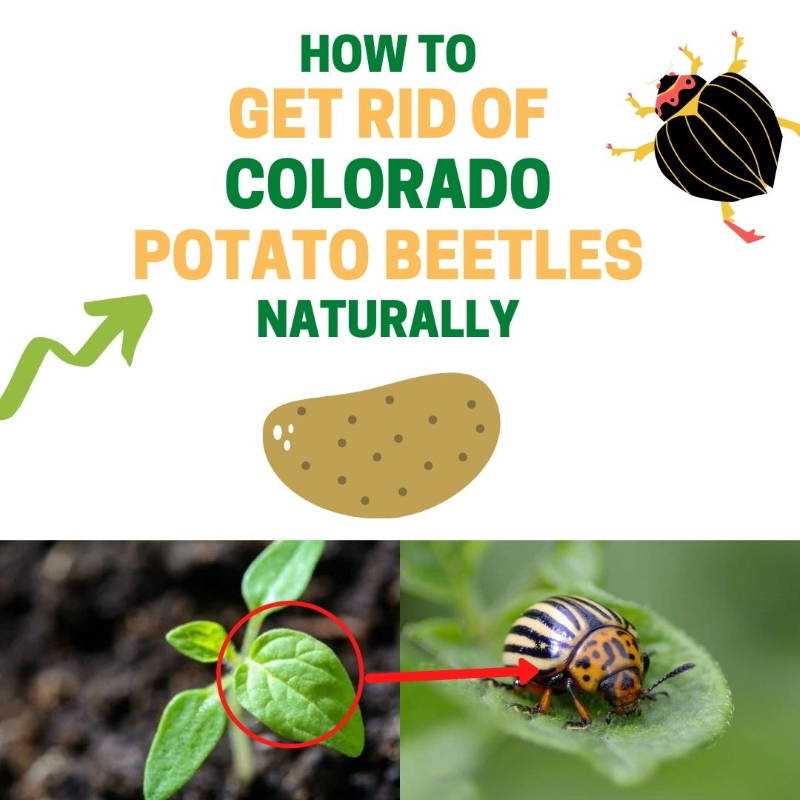
Cultural practices, such as timing planting and harvesting, can also help manage pest populations. By planting potatoes early or late in the season, farmers can avoid the peak activity period of Colorado potato beetles. Harvesting plants promptly after maturity can also minimize the time available for the beetles to lay eggs.
Conclusion
Integrated Pest Management techniques offer a sustainable and environmentally friendly approach to controlling the Colorado potato beetle and other pests. By combining various methods, farmers can effectively manage pest populations while reducing reliance on chemical pesticides. These techniques promote the health of crops, the environment, and overall agricultural sustainability.
Crop Rotation
Crop rotation is a commonly used method to naturally control the population of Colorado potato beetles. It involves the practice of planting different crops in a specific sequence on the same piece of land over time. This approach disrupts the life cycle of the beetles and reduces their ability to survive and reproduce.
How does it work?
Colorado potato beetles have a strong preference for potatoes as their food source. By rotating the crops planted in a field, the beetles are deprived of their preferred food and are forced to either migrate to a new area or feed on alternative plants. This interruption in their feeding cycle can help reduce infestations and prevent the build-up of beetle populations.
Steps to implement crop rotation:
- Plan a crop rotation schedule: Determine which crops will be planted in each field and the order in which they will be rotated.
- Vary the plant families: Avoid planting crops from the same family in consecutive seasons. Colorado potato beetles generally prefer plants from the Solanaceae family, which includes potatoes, tomatoes, peppers, and eggplants.
- Reduce overwintering sites: Clean up crop residue and weeds after harvest to minimize the beetles’ ability to find shelter and survive the winter.
- Monitor beetle populations: Regularly inspect plants for signs of beetle activity and implement additional control measures if necessary.
Benefits of crop rotation:
- Natural pest control: Crop rotation helps to break the lifecycle of Colorado potato beetles, reducing the need for chemical pesticides.
- Soil health: Different crops have varying nutrient needs. Crop rotation improves soil fertility and reduces the risk of nutrient depletion.
- Disease prevention: Planting unrelated crops can help break the cycle of pests and diseases that target specific plant families.
- Biodiversity: Crop rotation promotes biodiversity and ecological balance on the farm.
Conclusion
Crop rotation is an effective and environmentally friendly method to naturally control the population of Colorado potato beetles. By diversifying crops and interrupting the life cycle of the beetles, farmers can reduce their reliance on chemical pesticides and ensure the long-term health and productivity of their fields.
Biological Control Agents
Biological control is an effective and environmentally friendly method to manage pest populations, including the Colorado potato beetle. In this approach, natural predators and parasites are used to control the pest population. Here are some common biological control agents used against the Colorado potato beetle:
Ladybugs:
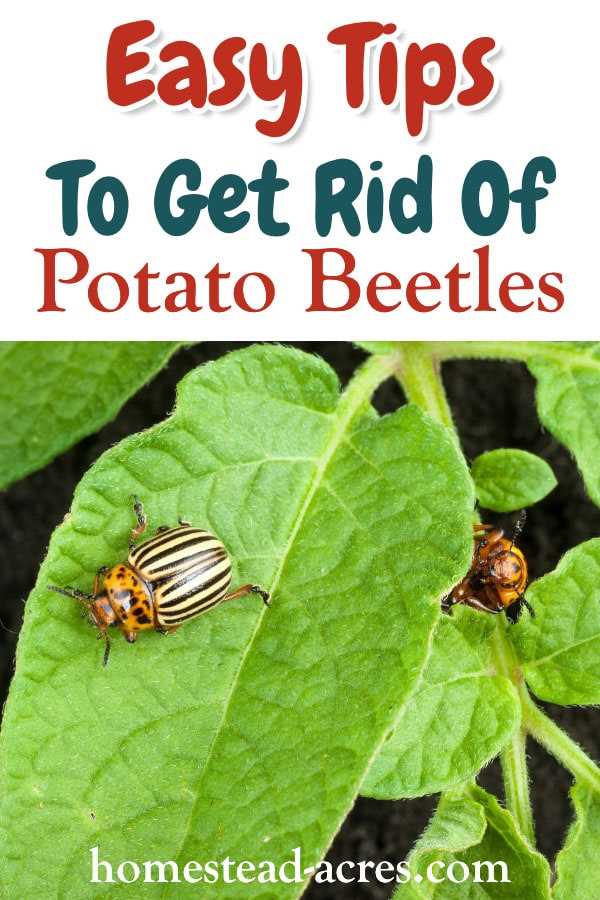
Ladybugs, also known as ladybirds or lady beetles, are widely used as natural predators of the Colorado potato beetle. They feed on the eggs, larvae, and adult beetles, helping to reduce their population. Ladybugs are known for their voracious appetite and can consume a large number of beetle eggs and larvae.
Ground beetles:
Ground beetles are another group of natural predators that can be beneficial in controlling the Colorado potato beetle. These beetles are active at night and feed on the eggs, larvae, and adult beetles. Their predatory behavior can significantly reduce the pest population.
Parasitic wasps:
Parasitic wasps are tiny, non-stinging wasps that lay their eggs in the Colorado potato beetle larvae. The wasp larvae then consume the beetle larvae, ultimately killing them. This method of biological control can be highly effective in reducing the pest population.
Nematodes:
Nematodes are microscopic worms that are used as biological control agents against various pests, including the Colorado potato beetle. These nematodes infect and kill the beetle larvae and pupae. They are applied to the soil, where they actively search for and attack the pest larvae.
Fungi:
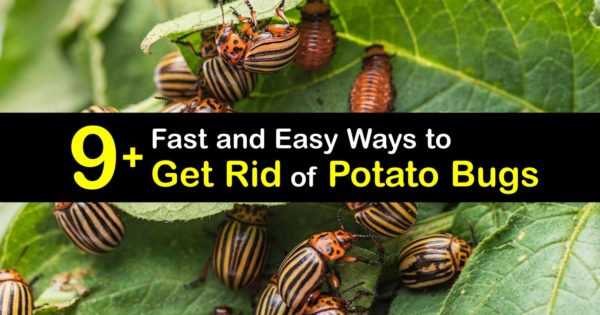
Several species of fungi, such as Beauveria bassiana and Metarhizium anisopliae, can naturally infect and kill the Colorado potato beetle. These fungi produce spores that adhere to the beetles’ bodies and penetrate their cuticles, causing them to become sick and eventually die. Fungal-based biopesticides are commercially available for controlling the pest.
| Biological Control Agent | Target Stage | Effectiveness |
|---|---|---|
| Ladybugs | Eggs, larvae, adults | High |
| Ground beetles | Eggs, larvae, adults | High |
| Parasitic wasps | Larvae | High |
| Nematodes | Larvae, pupae | High |
| Fungi | Eggs, larvae, adults | Medium to high |
Utilizing biological control agents can help to reduce the Colorado potato beetle population without relying on chemical insecticides. However, it is important to understand the specific requirements and conditions for each agent to ensure their effectiveness.
Physical Barriers
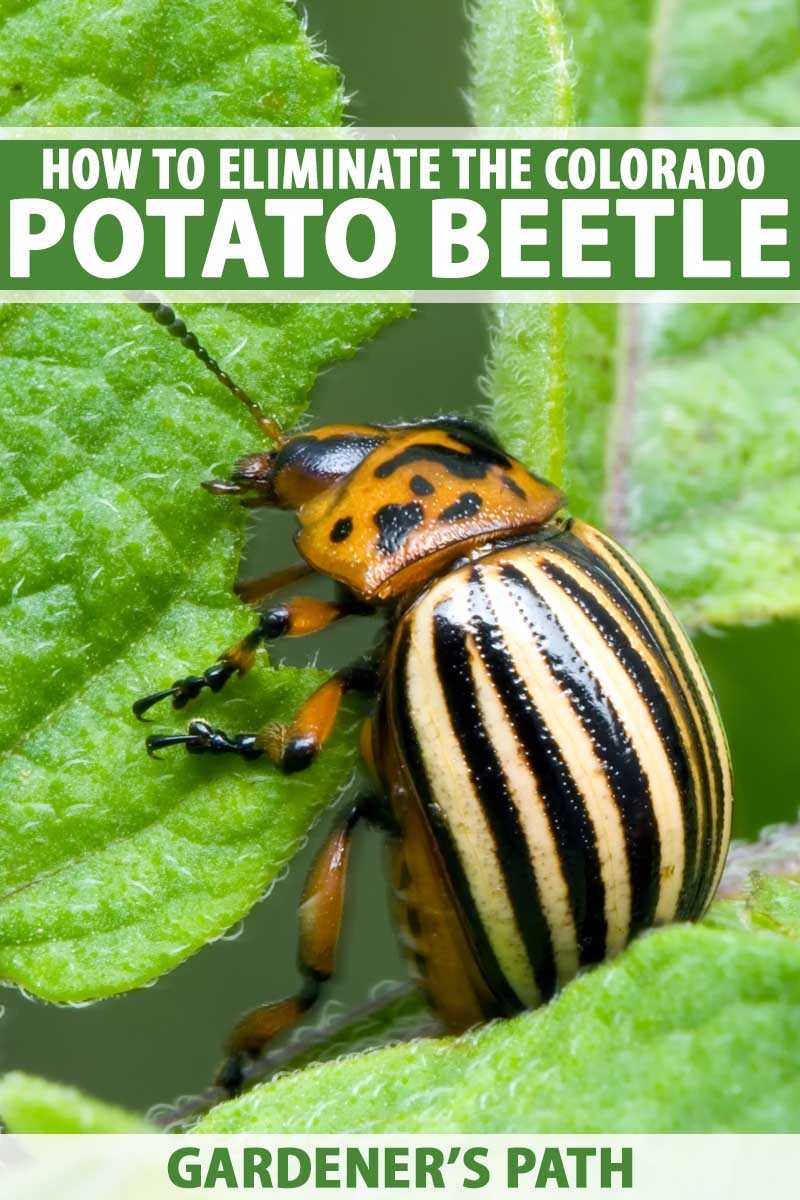
Physical barriers are a non-chemical method that can be used to eliminate Colorado potato beetles naturally. These barriers are created to prevent the beetles from reaching the plants and causing damage. They can be effective in reducing the population of the beetles and protecting the crops.
Types of Physical Barriers
There are several types of physical barriers that can be used to deter Colorado potato beetles. These include:
- Row Covers: Row covers are made from lightweight fabric and are placed over the plants to create a physical barrier between the beetles and the plants. The covers allow sunlight, air, and water to reach the plants while keeping the beetles out.
- Mulching: Mulching involves covering the soil around the plants with a layer of organic material, such as straw or wood chips. This creates a barrier that makes it difficult for the beetles to reach the plants.
- Barriers: Physical barriers, such as fences or screens, can be installed around the garden or individual plants to keep the beetles out. These barriers should be tall enough to prevent the beetles from crawling over or through them.
Benefits of Physical Barriers
Using physical barriers to eliminate Colorado potato beetles has several benefits:
- Environmentally friendly: Physical barriers do not involve the use of harmful chemicals, making them a safe and environmentally friendly option.
- Cost-effective: Physical barriers are often inexpensive and can be easily implemented by home gardeners.
- Effective control: When properly installed and maintained, physical barriers can effectively prevent Colorado potato beetles from reaching the plants.
- Protection against other pests: Physical barriers can also provide protection against other pests, such as rabbits or deer, depending on the type of barrier used.
Overall, physical barriers offer a natural and effective method for eliminating Colorado potato beetles and protecting potato crops. They provide a sustainable alternative to chemical pesticides and can be used by both home gardeners and larger-scale farmers.
Organic Insecticides
One effective way of controlling Colorado potato beetles naturally is by using organic insecticides. These insecticides are derived from natural sources and are considered safe for the environment and human health. Here are some of the popular organic insecticides that can help in eliminating Colorado potato beetles:
- Neem oil: Neem oil is extracted from the seeds of the neem tree and is a powerful organic insecticide. It affects the beetles’ feeding, growth, and reproduction, helping to control their population.
- Pyrethrin: Pyrethrin is a natural insecticide derived from dried flowers of certain chrysanthemum species. It is effective in killing Colorado potato beetles and other pests on contact.
- Spinosad: Spinosad is a naturally occurring soil bacterium that acts as an insecticide. It targets the nervous system of Colorado potato beetles and other pests, causing paralysis and death.
- Diatomaceous earth: Diatomaceous earth is made from the remains of fossilized diatoms. It contains sharp microscopic particles that pierce the exoskeleton of Colorado potato beetles, leading to dehydration and death.
It is important to follow the instructions provided by the manufacturers when using organic insecticides. Wear protective clothing and avoid spraying the insecticides directly on edible parts of the plants. Regular application and proper timing are crucial for effective control of Colorado potato beetles using organic insecticides.
Neem Oil
Neem oil is a natural and effective way to control Colorado potato beetles. It is derived from the neem tree, which is native to India and has been used for centuries for its medicinal and insecticidal properties. Neem oil is an organic and non-toxic substance that is safe for humans, animals, and beneficial insects.
How does neem oil work?
Neem oil contains compounds called azadirachtin, which disrupt the feeding and reproductive systems of Colorado potato beetles. When the beetles come into contact with neem oil, it affects their ability to eat and lay eggs, ultimately leading to their death.
How to use neem oil?
Neem oil can be applied on the leaves, stems, and soil around potato plants. To make a neem oil spray, mix 1-2 tablespoons of neem oil with 1 gallon of water and a few drops of dish soap. Spray the mixture onto the potato plants, focusing on the undersides of the leaves where the beetles tend to lay their eggs.
- Apply neem oil early in the morning or late in the evening when the sun is not too strong.
- Reapply the spray every 7-10 days or after rain to ensure continued protection.
- It is important to cover the entire plant, including the upper and lower leaf surfaces, stems, and buds.
Benefits of using neem oil:
- Organic and non-toxic
- Safe for beneficial insects
- Effective against Colorado potato beetles
- Prevents damage to potato plants
- Environmentally friendly
Using neem oil as a natural pesticide can help control Colorado potato beetles without introducing harmful chemicals into the environment. It is a sustainable and eco-friendly approach to pest management that supports healthy potato plant growth.
Diatomaceous Earth
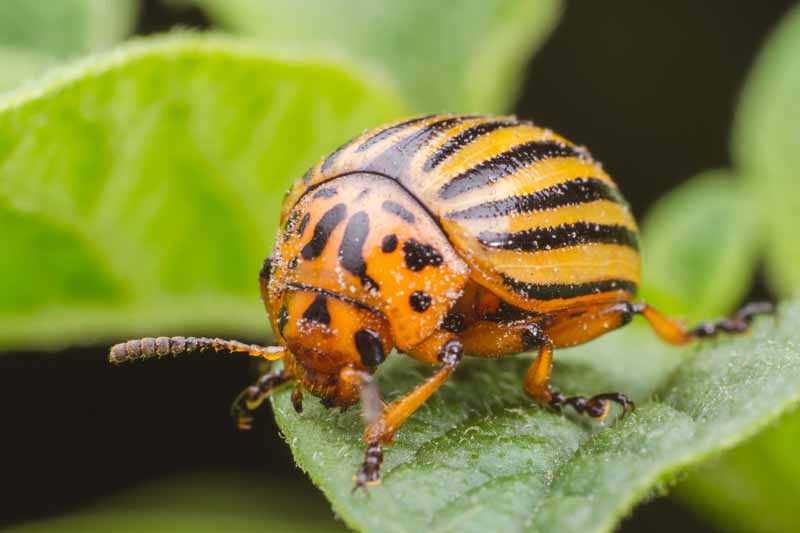
Diatomaceous earth, also known as DE, is a naturally occurring sedimentary rock that is commonly used as an organic pesticide and insecticide.
Here are a few reasons why diatomaceous earth is an effective and natural method to eliminate Colorado potato beetles:
- Physical damage: Diatomaceous earth has microscopic sharp edges, which can physically damage the exoskeleton of Colorado potato beetles. When these sharp particles come in contact with the bugs, they penetrate the outer layer, causing them to dehydrate and die.
- Non-toxic: Unlike chemical pesticides, diatomaceous earth is non-toxic to humans, animals, and beneficial insects. It can be used without worry in organic gardens and is safe for use around food.
- Long-lasting: Diatomaceous earth remains effective even after application. It can provide protection for up to several weeks as long as it stays dry and undisturbed. This makes it a great long-term solution for controlling Colorado potato beetles.
- Easy to use: Diatomaceous earth can be easily applied by dusting it directly on the foliage and soil around the potato plants. It can also be mixed with water and sprayed using a handheld sprayer. The particles will stick to the bugs and dehydrate them upon contact.
- Cost-effective: Diatomaceous earth is an affordable option for pest control. It is available in various sizes and quantities, allowing gardeners to choose what fits their needs best.
It’s important to note that diatomaceous earth should be used with caution. It can be harmful if inhaled, so it’s recommended to wear a mask during application. Additionally, it should not be used in areas with high wind or rain, as it can wash away and lose its effectiveness.
Overall, diatomaceous earth is a natural, non-toxic, and cost-effective solution for eliminating Colorado potato beetles in a safe and organic way. By incorporating this method into your pest control routine, you can protect your potato plants without harming the environment.
Traditional Methods
Before the advent of chemical pesticides, farmers relied on traditional methods to control pests like the Colorado potato beetle. These methods have been passed down through generations and are still used by many organic farmers today.
Handpicking
One of the most effective traditional methods of controlling Colorado potato beetles is handpicking. Farmers and gardeners can manually remove the beetles and their eggs from the plants by hand. This method requires diligence and regular monitoring of the plants.
Row Covers
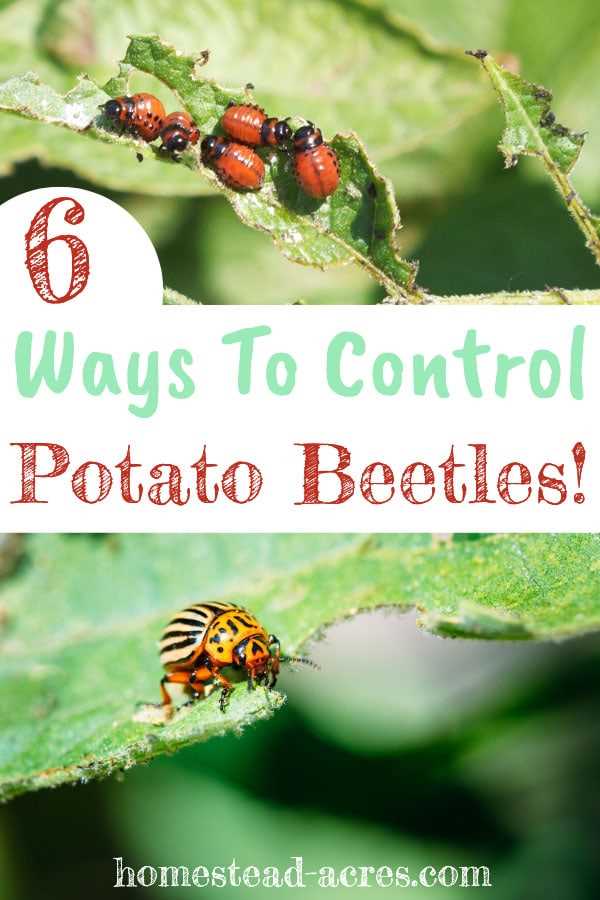
Using row covers is another traditional method to protect potato plants from Colorado potato beetles. Row covers are made of lightweight fabric that allows sunlight, air, and water to reach the plants but prevents pests from reaching them. Row covers should be placed over the plants early in the season, before the beetles emerge.
Crop Rotation
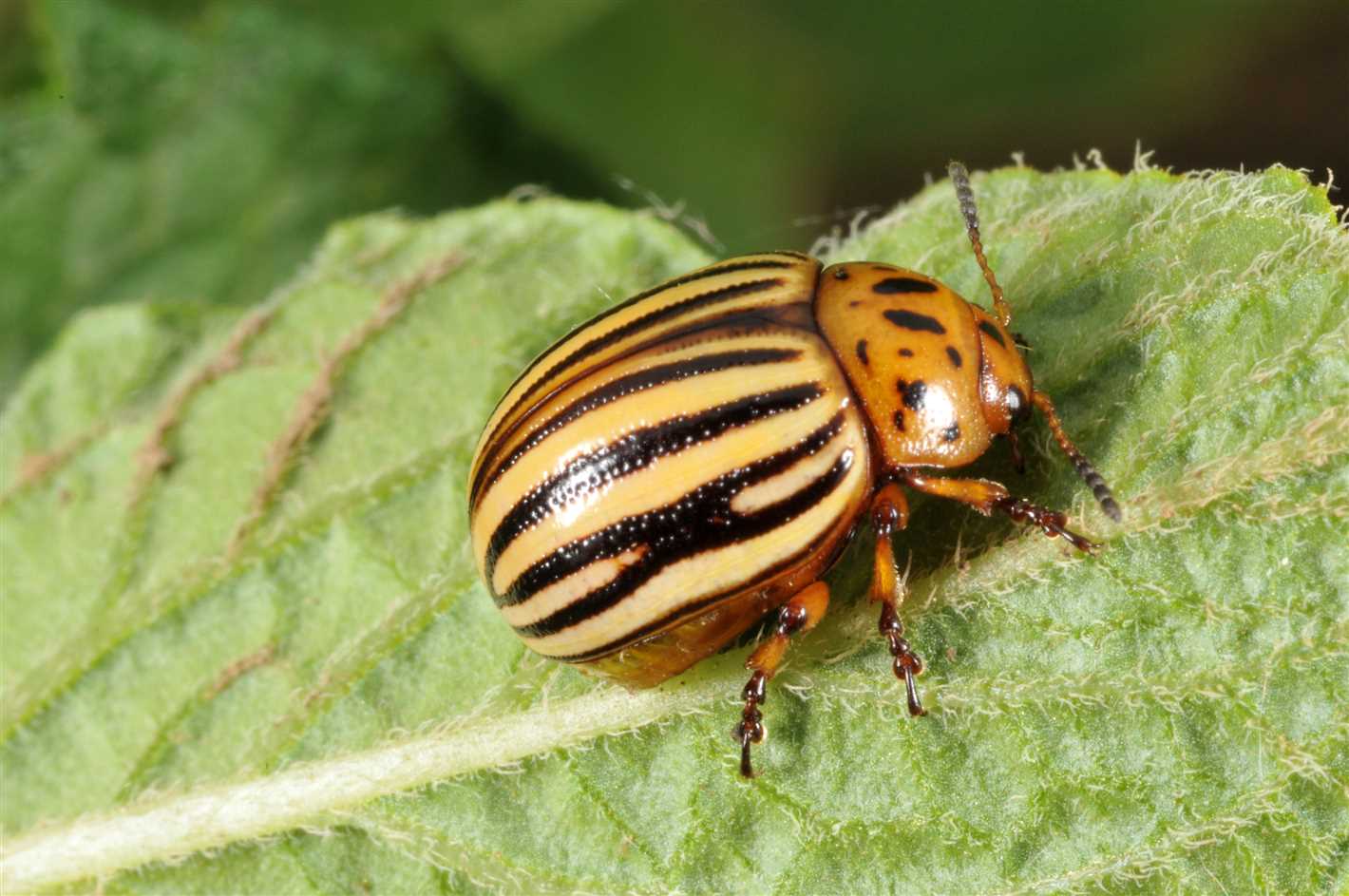
Crop rotation is a traditional practice that involves changing the location of potato plants each year. This helps disrupt the life cycle of Colorado potato beetles, as the pests will not find their preferred host plants in the same area. Crop rotation can help reduce the population of Colorado potato beetles over time.
Natural Predators
Encouraging natural predators of Colorado potato beetles is another traditional method of control. Predatory insects and birds, such as ladybugs, ground beetles, and certain bird species, feed on Colorado potato beetles and their larvae. Providing habitats and food sources for these natural predators can help keep the beetle population in check.
Trap Crops
Using trap crops is a traditional method that involves planting a sacrificial crop specifically to attract Colorado potato beetles. The idea is to lure the beetles away from the main potato crop and onto the trap crop. Once the beetles are concentrated on the trap crop, they can be removed or destroyed.
| Method | Effectiveness | Cost | Ease of Use |
|---|---|---|---|
| Handpicking | High | Low | Medium |
| Row Covers | High | Medium | Medium |
| Crop Rotation | Medium | Low | Medium |
| Natural Predators | Medium | Low | Medium |
| Trap Crops | Low | Medium | Medium |
“Question-Answer”
What is the Colorado potato beetle?
The Colorado potato beetle (Leptinotarsa decemlineata) is a destructive pest that feeds on potato plants.
Why is the Colorado potato beetle considered a pest?
The Colorado potato beetle is considered a pest because it can cause significant damage to potato crops, reducing yield and quality.
What are some natural methods to eliminate Colorado potato beetles?
Some natural methods to eliminate Colorado potato beetles include crop rotation, handpicking, using beneficial insects like ladybugs, and applying organic insecticides.
Why should we use non-chemical methods to control Colorado potato beetles?
Using non-chemical methods to control Colorado potato beetles is beneficial because it reduces the use of harmful pesticides, which can have negative effects on the environment and human health.
Is crop rotation an effective method to control Colorado potato beetles?
Yes, crop rotation is an effective method to control Colorado potato beetles. By planting potatoes in a different area each year, the beetles are less likely to find and infest the crops.
Are there any downsides to using non-chemical methods to control Colorado potato beetles?
One potential downside to using non-chemical methods is that they may require more time and effort compared to using chemical pesticides. Additionally, non-chemical methods may not be as effective in controlling large infestations.







